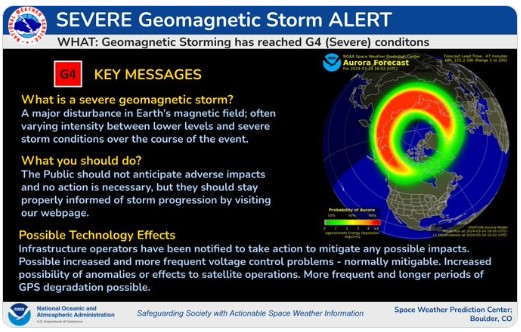
A rare celestial event is currently unfolding, as a severe geomagnetic storm triggered by eruptions from the Sun has the potential to illuminate the skies with Northern Lights as far south as Alabama and Northern California. This remarkable phenomenon is capturing the attention of space enthusiasts and stargazers alike, offering a unique opportunity to witness the auroras in unexpected locations.
The National Oceanic and Atmospheric Administration's Space Weather Prediction Center (SWPC) issued a Geomagnetic Storm Alert on Sunday following the detection of an X 1.1 solar flare and subsequent coronal hole high-speed stream (CH HSS) directed towards Earth. These eruptions from the Sun have set the stage for an impressive display of Northern Lights, also known as auroras, as charged particles from the Sun interact with the Earth's atmosphere.
Experts at the SWPC have rated the geomagnetic storm on a five-point scale, initially expecting it to reach a G1 or G2 level. However, within the past 24 hours, the severity escalated to a G4 rating, indicating severe space weather conditions. This unexpected surge in intensity has heightened the anticipation for dazzling auroral displays, potentially visible in regions as far south as Alabama and Northern California.
A full halo CME was detected in NASA/SOHO coronagraph imagery as seen in this https://t.co/aKDvZ0ApRZ video showing the massive CME departing the Sun. The CME was associated with the X1 (R3) flare and SWPC forecasters are now analyzing for Earth-directed potential. Stay tuned! pic.twitter.com/gs9n8VZt8S
— NOAA Space Weather (@NWSSWPC) March 23, 2024
Auroras are a captivating natural phenomenon resulting from the interaction of solar particles with the Earth's magnetic field. Typically, they are observed closer to the Earth's polar regions, but during intense geomagnetic storms, they can extend much farther south, creating breathtaking vistas for observers.
The University of Alaska Fairbanks Geophysical Institute has forecasted high aurora activity with Kp-6 levels expected through Monday night. The Kp index scale, ranging from 0 to 9, measures geomagnetic activity, with higher values indicating increased auroral visibility. Space experts anticipate that this event could reach a Kp-index value of at least 6, potentially making auroras visible in cities such as Seattle, Minneapolis, Green Bay, and Syracuse, New York.
The 23 March CME arrived at around 24/1411 UTC. Severe (G4) geomagnetic storming has been observed and is expected to continue through the remainder of the 24 March-UTC day and into the first half of 25 March. pic.twitter.com/CDXQtyv4yp
— NOAA Space Weather (@NWSSWPC) March 24, 2024
Despite the excitement surrounding this celestial event, viewing conditions may be hindered by various factors. A large storm system moving through the country's heartland is expected to bring snow and thunderstorms, leading to increased cloud cover in many areas. Additionally, March's full Worm Moon will illuminate the sky, potentially impeding visibility of the Northern Lights.
Furthermore, a faint lunar eclipse is set to occur shortly before 1 a.m. EDT on Monday, lasting until approximately 5:30 a.m. These celestial events, while captivating in their own right, may pose challenges for aurora enthusiasts hoping to catch a glimpse of the spectacular light show.
Space experts acknowledge the difficulty in precisely predicting the strength of geomagnetic activity, particularly as the Sun approaches the maximum phase of its solar cycle. Geomagnetic storms have become more frequent over the past year as Solar Cycle 25 progresses, a natural cycle lasting approximately 11 years during which the Sun's magnetic field undergoes significant changes.
While the exact outcome of this geomagnetic storm remains uncertain, it presents a rare opportunity for residents of the southern United States to witness the awe-inspiring beauty of the Northern Lights. As nature puts on a dazzling display in the night sky, observers are encouraged to stay informed about the storm's progression and remain vigilant for potential auroral sightings.
In conclusion, the convergence of solar activity and Earth's magnetic field has set the stage for a remarkable celestial event, offering a glimpse of the Northern Lights in unexpected locations across the southern United States. Whether or not these elusive auroras grace the night sky, the anticipation and excitement surrounding this event serve as a reminder of the wonders of the universe and our ever-changing cosmic environment.
Leave a Reply